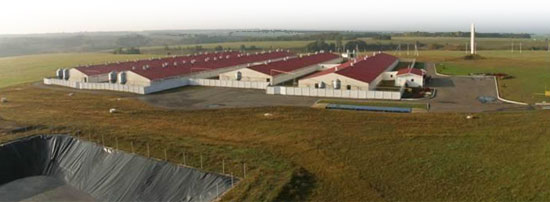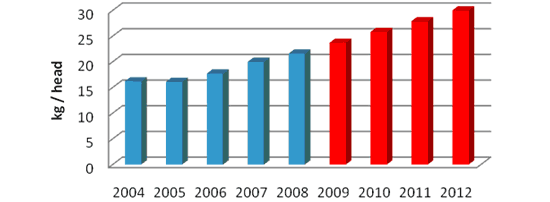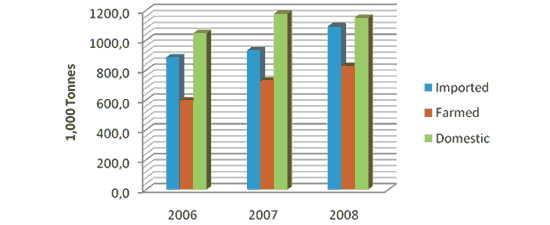
New nucleus farm in Russia
Pigmeat consumption is currently at just over 21kg per head and has been increasing year on year since 2004 as a result of improving economic conditions and higher disposable incomes. The target for consumption is 30kg per head by 2012.
Pigmeat consumption per person

Sow numbers are about 1.8 million with nearly 60% of production still ‘backyard’. This type of production is decreasing, as is expected in a growing economy. The real changes are happening in commercial farmed units where production is increasing at a rate of nearly 20% per year.
Pigmeat production and importation

This year the amount of meat imported into Russia will not be increased. The predicted rise in consumption will be met by increased production from commercial pig units. This policy helps to maintain good margins for efficient farms.
Russia is well known for its cohorts or state farms. These were large farrow to finish units of up to 6,000 sows. Although still in production many of these farms are now old with low productivity and in need of refurbishment.
Russia has a new breed of pig farmers. These are either companies that previously slaughtered or imported and processed meat that are building pig farms, or completely new companies (with regards to farming) starting from scratch and building farms, feed mills and slaughter and processing plants. In Russia’s top 20 pig farming enterprises 7 did not have a single pig in 2006!
These modern units fit into 2 main categories. The first are 5,000 sow multi site (normally sow farm, 1 or 2 nurseries sites and 2 or 3 finisher sites). The alternative is 2,500 to 3,000 sow farrow to finish. The vast majority of new farms are fully integrated with land to produce feed ingredients and for slurry disposal, feed manufacture, farms, slaughter and processing.

New 5,000 sow farm
Alongside new and old pig units there is new and old genetics. Historically Russia had an excellent national breeding program which all but stopped functioning during Russia’s last financial crisis. This has meant that genetic material from Western Europe and Canada is now far advanced from what is available locally. The new farms are stocked with what is for Russia ‘new genetics’. Traditional breeds are delivering around 16 pigs sold per sow per year, FCR’s of 3.5:1 in finishing and backfat in excess of 20mm. New farms are performing as well as anywhere in Europe.
Nutrition is improving too. Most of the feed companies we know in the West are represented in Russia. Many farms feed piglets diets manufactured in Western Europe and imported into Russia. This in time will be manufactured locally as the standards of feed mills improve. Historically Russia has had problems with the quality of raw materials and in particular micotoxins. This is due to lack of fungicide use in growing crops and poor drying and storage. With all other aspects of management this too is improving. Russia has the ‘bread basket’ of Europe and is capable of massive increases in cereal production.

Europe’s breadbasket
Most new farms are stocked with high health pigs originally imported from Europe or Canada. Older farms suffer from all of the diseases we are familiar with. Vaccine use is very high, due to the availability of locally made low cost vaccines. One worry for Russia currently is an outbreak of african swine fever that is proving difficult to control. New farms are well built with excellent bio-security measures, old ones are not, added to this the problem of any form of effective veterinary supervision of back yard production is a challenge for the veterinary authorities.
Production costs for modern efficient producers are about €1.00 per kg with a sale price currently at €1.65 these farms are very profitable. This however is not the same for all producers. Price is linked to backfat, so producers using traditional breeds are receiving a much lower price for their meat and with low productivity and poor FCR much higher costs.
Russia is aiming for self sufficiency in pigmeat. This currently means an additional 500,000 sows are needed. As population grows or per capita consumption increases then this will require even more sows. If the current building program of new pig units continue, then this target seems to be a reality.





